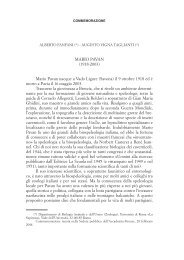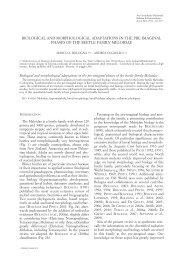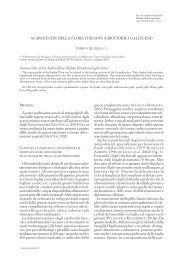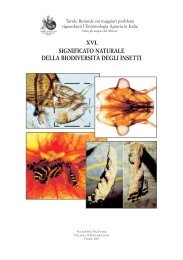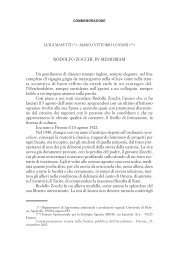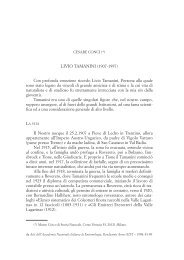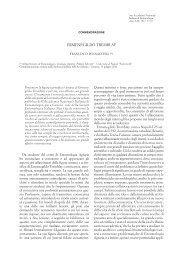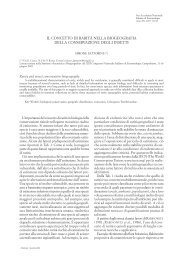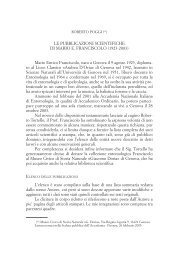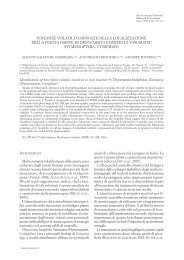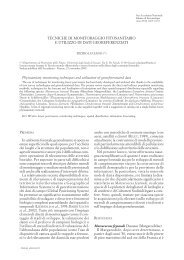XXII CNIE - Accademia nazionale italiana di Entomologia
XXII CNIE - Accademia nazionale italiana di Entomologia
XXII CNIE - Accademia nazionale italiana di Entomologia
You also want an ePaper? Increase the reach of your titles
YUMPU automatically turns print PDFs into web optimized ePapers that Google loves.
However, a major issue consists in understan<strong>di</strong>ng whether the observed changes can<br />
really be attributed to a variation in climatic con<strong>di</strong>tions. It is usually <strong>di</strong>fficult to entirely<br />
<strong>di</strong>sentangle the effect of climate change from that of other physical or chemical factors,<br />
and/or other biotic causes, especially man-me<strong>di</strong>ated changes in land use and habitat<br />
mo<strong>di</strong>fications (). Most stu<strong>di</strong>es have focused on the effects of temperature, but other<br />
climatic factors are probably important as well, e.g., isolation, relative humi<strong>di</strong>ty, rainfall,<br />
CO2 concentration …, and that is their combination which really determines the weather<br />
con<strong>di</strong>tions experienced by the in<strong>di</strong>viduals. For instance, the establishment of an invasive<br />
Asian mosquito, Aedes albopictus (Diptera: Culicidae), depends on temperature but also<br />
on photoperiod, humi<strong>di</strong>ty and rainfall (Eritja et al., 2005). Even though testing the effect<br />
of one factor in laboratory con<strong>di</strong>tions is relatively easy, testing the effects of numerous<br />
factor combinations is extremely complex and some contra<strong>di</strong>ctory results may appear<br />
(see Newman, 2005). Moreover, climate change may affect not only insect populations<br />
but also their host plants, natural enemies, mutualists, and competitors (Ayres &<br />
Lombardero, 2000; Walther et al., 2002).<br />
In this paper, we (1) synthesize the evidence for changes in insect biological invasions<br />
arising from recent climatic changes, (2) evaluate the relative importance of both the<br />
<strong>di</strong>rect and in<strong>di</strong>rect effects of climate change on insect invasions, (3) contrast these<br />
fin<strong>di</strong>ngs with stu<strong>di</strong>es on climate-induced changes of native insect species, and (4) try to<br />
identify trends for the future.<br />
Global warming is offering new opportunities for introductions<br />
Populations of alien insects are considered more likely to survive if they are introduced<br />
to areas with climatic con<strong>di</strong>tions similar to those in their native <strong>di</strong>stribution range.<br />
Temperature is a key factor affecting growth, survival and reproduction in both a <strong>di</strong>rect<br />
and in<strong>di</strong>rect way. Hence, the survival of alien species introduced from habitats in<br />
warmer regions to new areas with harsher con<strong>di</strong>tions either depends on locally heated<br />
‘islands’ or on changing climate in the introduced range. Urban areas act as warm<br />
islands in northern latitudes provi<strong>di</strong>ng opportunities for e.g. thermophilous ants such as<br />
Lasius neglectus (Dekoninck et al., 2002). Anthropogenic habitats, especially buil<strong>di</strong>ngs,<br />
are also first habitats for spiders alien in or to Europe (Kobelt & Nentwig 2008).<br />
Similarly, Kiritani (2006) suggested greenhouses in temperate environments that host<br />
exotic pests of sub-tropical or tropical origin, as a model of outdoor temperate agroecosystems<br />
after global warming. Indeed, about 66% of the exotic insect species<br />
established in Europe are only found in anthropogenic habitats at this moment (Roques<br />
et al., 2009).<br />
Global warming could provide new opportunities for introductions to areas where, until<br />
recently, introduced species were not able to survive. Former greenhouse inhabitants,<br />
such as three exotic scale species, Diaspi<strong>di</strong>otus <strong>di</strong>stinctus, Coccus hesperidum and<br />
Icerya purchasi, have recently been found outdoors in Switzerland (Kenis, 2006). Also<br />
non-native biological control agents of greenhouse pests start to establish outside the<br />
greenhouse environment, such as the predatory bug Macrolophus caliginosus (Hart et<br />
al. 2002) and the predatory mite Neoseiulus californicus (Hatherly et al. 2005) in the<br />
UK. Similarly, pine processionnary moth, Thaumetopoea pityocampa, has recently been<br />
accidentely introduced with large potted pine trees in the Alsace region of France, i.e.,<br />
180 km far beyond its natural range. Whilst the climatic con<strong>di</strong>tions <strong>di</strong>d not allow larvae<br />
to survive during the 1990s because of winter temperatures under the survival<br />
thresholds, the warming up of the area since 2000 resulted in the establishment of self-<br />
sustaining moth populations.<br />
In ad<strong>di</strong>tion to the removal of physiological constraints, climate change may also open up<br />
unprecedented introduction pathways. The long-range <strong>di</strong>ssemination of organisms by air<br />
12



